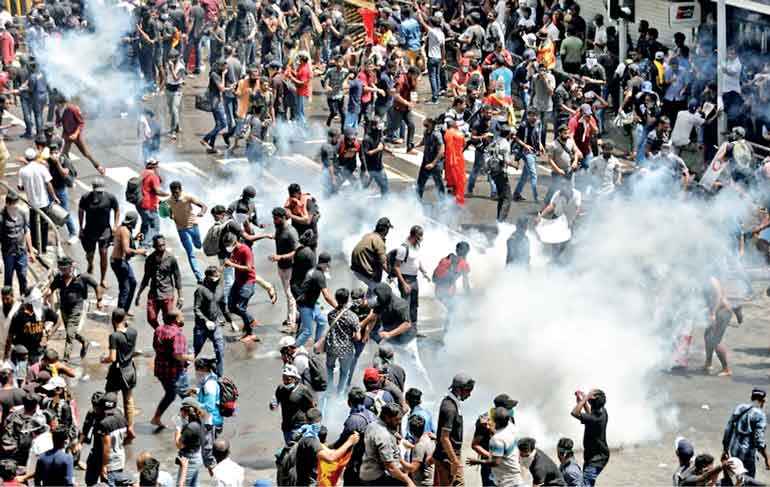Wednesday Nov 19, 2025
Wednesday Nov 19, 2025
Saturday, 20 July 2024 00:00 - - {{hitsCtrl.values.hits}}

That uprising exposed at last the vacuity of SBM as a constructive national ideology and signalled the need for a model of governance that would deliver those ideals
 The 2022 Aragalaya was a landmark event in Sri Lankan politics. It was the harbinger for a new era in which the old political culture and governance with all its accoutrement would be thrown out and a new system of governance free of all past evils would be put in place. It was therefore an opportunity for the minorities who had suffered continually and immensely in the previous era to welcome this occasion. Instead, and shockingly, they are caught in a quandary and appear to have become saboteurs of the new and guardians of the old era.
The 2022 Aragalaya was a landmark event in Sri Lankan politics. It was the harbinger for a new era in which the old political culture and governance with all its accoutrement would be thrown out and a new system of governance free of all past evils would be put in place. It was therefore an opportunity for the minorities who had suffered continually and immensely in the previous era to welcome this occasion. Instead, and shockingly, they are caught in a quandary and appear to have become saboteurs of the new and guardians of the old era.
Pre-Aragalaya politics
For the last seven decades under a twisted parliamentary democracy the Tamil and Muslim minorities had been targeted victims of a political culture underwritten by the ideology of Sinhala-Buddhist Majoritarianism (SBM). Neither the Sinhalese as people and community nor Buddhism as way of life and faith was responsible for this culture and ideology. On the contrary, their innocence was intentionally galvanised and profitably exploited by generations of Sinhala Buddhist chauvinists who with support from sections of the Sangha and academia found divide and rule the most preferable art of governing pluralist Sri Lanka. They viewed the Tamils as a mortal threat to Sinhala Buddhist supremacy and Muslims as outright aliens. It was this politically manufactured and diabolic ideological paradigm that produced different models of governance to rule over Sri Lanka’s plural polity.
To counter this culture and ideology, Tamil politicians advocated federalism as the most preferred solution and agitated for it with non-violent means, but when that failed to win favour with SBM leadership a new generation of young Tamil rebels resorted to armed struggle from the 1980s with uncompromising determination to divide the country. That romantic misadventure ended in total disaster and bloody mayhem as expected. The rebels were totally annihilated by the SBM gendarmerie of the State. Currently, and perhaps to pick up the pieces, Tamil politicians are demanding at least the implementation of the India mediated 12th Amendment which concedes an element of power devolution to Tamil dominant areas but within an undivided nation. Although Sinhala political leaders are tantalising Tamil voters with promises of implementing that amendment, the old guards of SBM however, would have none of it.
Muslims on the other hand who had earned the sobriquet business community from the British, employed their business acumen and bargaining tactics to support whichever government that came into power and consequently were able to win a number of favours from SBM, which at times were at the expense of the Tamil minority. For example, if not for the growing division between SBM and the Tamils in 1950s and ‘60s the establishment and growth of Muslim Tamil schools as a separate category would have been a problem. The political history of Muslims in independent Sri Lanka is an outstanding illustration of how a small minority could profitably utilise the same strategy of divide and rule adopted by SBM to advance Muslim interests.
Muslim leaders adopted that strategy more successfully until 1990s when they did not have a political party of their own, and leading local historians ennobled Muslim political opportunism as politics of pragmatism. Yet, that strategy too passed its use by date once the Tamils were defeated militarily at the battle front. With the formation of a Muslim political party in 1988, which later split into two, and with the spread of imported waves of Islamic puritanism, anti-Muslim rage among SBM demagogues reached new heights after 2009 and invariably burst into cycles of anti-Muslim violence. While SBM thugs and hooligans unleashed that violence on living Muslims, an SBM state did it even on the dead as captured in Aman Ashraf’s documentary film “Oddamavadi”.
In the meantime, and within the majority Sinhalese community the political attraction of SBM showed signs of waning when economic conditions began to deteriorate. A triumphalist parvenu political leadership which was put in power went on a spending spree in the name of national development with money the state treasury did not have. Borrowing and spending without accountability and on projects intended more to enhance the personal prestige of leaders than productivity of the economy and welfare of the people became a licensed tradition blessed by SBM ideology, which began to impoverish millions of ordinary households.
That “immiserisation” through callous economic mismanagement reached its apex after 2020 when President Gotabaya Rajapaksa the so-called protector of Buddha Sasana went on an experimental but undefined path of economic development on the advice of his Viyathmaga thinktank and assisted by pliant central bankers. That experiment in combination with the COVID pandemic ultimately bankrupted the nation. It was then that a politically awakened generation of Sinhalese, Tamil and Muslim youth staged the Aragalaya in 2022, which in many ways was a positive shock signalling a new dawn.
Post-Aragalaya challenge
For the first time since the disappearance of the left parties from political horizon, a young generation of adults from all ethnic groups and faiths rose in revolt against a political culture that had become brazenly discriminatory, corrupt, paternalistic and therefore unjust. In that sense Aragalaya was not only a political but also a moral revolt. Its demand for “system change” was a demand for democratic justice and economic justice for all citizens of Sri Lanka. That uprising exposed at last the vacuity of SBM as a constructive national ideology and signalled the need for a model of governance that would deliver those ideals. If anything, that youth movement demonstrated that the moment has arrived for a new era of political experiment.
The substance of Aragalaya’s call for system change was not made sufficiently clear at that time, but it came to the fore when the National People’s Power (NPP) coalition – the child of Aragalaya – came out with the resolve to change the country’s “political culture via a social revolution”. This change in political culture cannot take place however, without overthrowing the ideology which gave birth to it. In other words, the hidden message of Aragalaya was that SBM had outlived its usefulness and had become the root cause of today’s poly-crisis. If this is not a sign of political awakening within the majority community what else? The most crucial factor in the timing of the Aragalaya was that it took place after the February 2021 Tamil demonstration, “From Poththuvil to Polikandi”, which was also led by thousands of young Tamils and Muslims. Both indicate a generational divide in the politics of this country, which cannot be ignored in any serious analysis.
But how has traditional minority politics responded to this awakening? Not very encouragingly and rather disappointingly. To start with, Tamil politicians who are demanding the implementation of the 13th Amendment fail to realise that that Amendment was a compromise solution not to do away with SBM but to share the majoritarian ideology between Sinhala Buddhists and Tamils in such a manner that the former would rule unchallenged in seven of the nine provinces while the latter in the other two. The Muslim minority was left out of this equation. No wonder Muslims protested against it. They have several reasons to fear Tamil dominance especially in the Eastern Province. The ongoing tussle over Kalmunai local council for example, is an index of this fear.
But what do Muslims themselves actually want? They themselves don’t seem to know the answer. Their politics has always been tangential to the national currents. But as usual and as an election nears Muslim parties once again are on a bargain spree within the old order and with traditional parties to win personal gains rather than to advance their community’s or national interest. In short, both minorities are still living in the past without realising that changes are afoot within the majority community.
NPP wants to go beyond the 13th Amendment and introduce a political culture that would eschew ethnonationalism and create a society and polity where minorities could live with dignity and justice, and contribute their best to the development of this nation. The choice is therefore clear. Either the minorities get out of their present quandary and go for a radical change, ally with a new generation of politicians and build a united Sri Lanka where meritocracy and not ethnicity and religion would be the desideratum for positions and rewards or continue with the status quo and suffer even more in the future. Ball is in their court.
(The writer is attached to Business School, Murdoch University, W. Australia.)